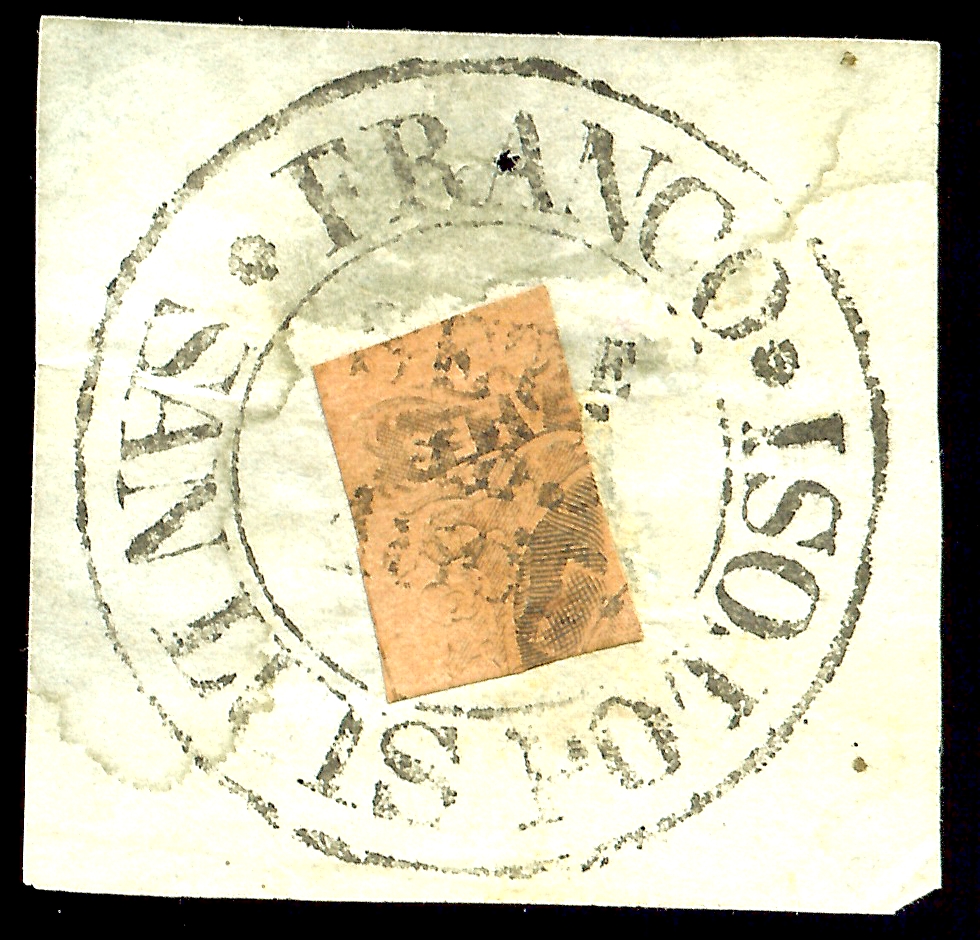Bisect (philately) on:
[Wikipedia]
[Google]
[Amazon]
 Bisects and splits refer to
Bisects and splits refer to
File:Cuba1868-BiscectedStampCover.jpg, Bisected stamp (with regular full stamp) on an 1868 letter from Matanzas to Guanajay, La Habana Province, Cuba. The 20 céntimos stamp was cut in half to be used as a 10 céntimos de escudo stamp. The bisect is cancelled with a parilla handstamp and the other is a pen cancellation.
File:Stamp US 12c bisect on Sonora cover (Siegal 2004).jpg, United States 1851, provisional or unofficial diagonal bisect of 12 cent stamp Scott catalogue, United States, no. 17. used as 6 cents.
File:Bolivia 1924 revenue stamp 6 times 10c bisect used on piece 17 Jun 1926.JPG,
 Bisects and splits refer to
Bisects and splits refer to postage stamp
A postage stamp is a small piece of paper issued by a post office, postal administration, or other authorized vendors to customers who pay postage (the cost involved in moving, insuring, or registering mail), who then affix the stamp to the f ...
s that have been cut in part, most commonly in half, but also other fractions, and postally used for the proportionate value of the entire stamp, such as a two cent stamp cut in half and used as a one cent stamp. When stocks of a certain stamp ran out, postmasters sometimes resorted to cutting higher denominated stamps in half, vertically or diagonally, thus obtaining two "stamps" each representing half of the original monetary value, or "face" value, of the uncut stamp. The general public also resorted to this practice, sometimes pursuant to official or tacit permission and sometimes without any express authorization.
Many of these instances have been well documented in postal history. One example is the bisects of the Island of Guernsey during the German military occupation of the Channel Islands
The military occupation of the Channel Islands by Nazi Germany lasted for most of the Second World War, from 30 June 1940 until liberation on 9 May 1945. The Bailiwick of Jersey and Bailiwick of Guernsey are two island countries and British Cr ...
during World War II
World War II or the Second World War, often abbreviated as WWII or WW2, was a world war that lasted from 1939 to 1945. It involved the vast majority of the world's countries—including all of the great powers—forming two opposing ...
. Early Mexican stamps are known to have been used cut in half, three-quarters, quarters and even eighths.
Many bisects and splits are considerably more valuable than the stamps from which they were made. These, however, only have philatelic
Philately (; ) is the study of postage stamps and postal history. It also refers to the collection and appreciation of stamps and other philatelic products. Philately involves more than just stamp collecting or the study of postage; it is possi ...
value when the cut portion is still affixed to the envelope or a piece showing the postmarks, as otherwise it cannot be confirmed that the stamp was in fact postally used as a split and not simply a complete stamp that was cut up after use.
Gallery
Revenue stamp
A revenue stamp, tax stamp, duty stamp or fiscal stamp is a (usually) adhesive label used to designate collected taxes or fees on documents, tobacco, alcoholic drinks, drugs and medicines, playing cards, hunting licenses, firearm registration, ...
s of Bolivia bisected on a fragment of a 1926 document.
File:Horta 1894 Sc1 bisect.jpg, Horta 1894, 5 reales bisected for use as 2.5 reales.
File:Uruguay 1883 bisect.jpg, Uruguay 1883, 10 centimos bisected for use as 5 centimos.
References
{{reflist Philatelic terminology